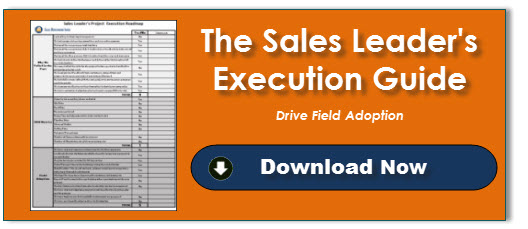A year ago at this time, you decided what sales improvement projects to pursue. You are looking back wondering if you got a return. Did revenue per head increase? Did the project help you make the ’13 number? Your boss is asking “what did we get for the money we spent?” It is a fair question. You are asking the same one.
Download the Sales Leaders’ Execution Guide here. You will receive the following benefits:
- Avoid the execution mistakes of the past
- A list of the key leading and lagging metrics to measure success
- Accelerate the behavior change in your sales leaders
- A detailed plan to drive sales rep adoption
Your Team’s Struggles
Field execution is spotty. You are lacking evidence that the sales team adopted the new behavior. You are attempting to secure budget and getting push back. Perhaps the reason you don’t have results is because the team didn’t execute. Or, they did execute initially but the revenue didn’t show up instantly. As a result your boss told you to “get back to basics”. This post discusses overcoming these two common problems that lead to failed improvement projects.
Problem 1—Poor Roll Out
You rolled out 2013’s initiative at sales kickoff. It was done via event based training. You know you needed more time. Unfortunately, somebody in marketing gave you one day because “the agenda is packed.” You knew you needed more time but you pushed on. Because you believe you have capable people, you delivered the training. They will get it. During the training, everybody nods. You say things like “if you guys don’t agree, please speak up.” Crickets.
Problem 2—You Panicked
You felt you were getting good traction in Q1. People were starting to change behavior. The SVP of Sales was looking to see the Q1 booking number move. The CEO was asking him “did the training work?” You had a slow Q1 and because of that, you abandoned the reinforcement. You had the right initiative but no evidence. You needed leading indicators and a little patience. Time flies; if only your team would have stuck with the new behavior. You would have been able to build on that throughout 2014.
Why 2014 Can Be Different—Agile Execution

What is Agile Execution—Agile is an iterative and collaborative approach to driving change. Specifically, it is focused on field adoption of new sales initiatives. For the sales leader, it focuses on early leading indicators. It promotes adaptability and encourages rapid response to change. The process is built by the same people that are expected to adopt it.
Agile Broken Down
There are 5 steps:
- Prototype—Start by using a generic template to your initiative. This less customized approach is about speed to market in the field. You are striving for the team to be testing the new process. This solves the common mistake of spending months in design. Instead, you get to “good enough” . Let the team use the new tool or process. Gaining field proof solves early adoption issues.
- Field Validation—Have a small group of reps and managers use the generic prototype. They will provide feedback. From here, you can make changes. Because you have field feedback, adoption starts to grow. Their fingerprints are on design and the process is real, not theoretical. This solves over engineered approaches when somebody in training design a new process. This helps solve ongoing adoption issues.
- Leadership Validation—Have the sales leaders use the new coaching or reinforcement tools. Have the leaders edit and critique the tools. You want pushback. You want skepticism. Because when you make changes, you will have their contributions. This solves front line management not feeling part of the design. They now take ownership.
- General Release—You now have something you can put in front of your broader sales team. They will feel it is battle tested. This solves for passive resistance. You have the individual contributors vouching for the new process. You have leading indicators you can point to from the field.
- Adoption—75% of your time should be spent in this phase. A great example of an adoption plan for a new sales process is here. In this phase you are striving for multiple different forms of adoption:
- Communication from your boss
- Time in field
- Gamification
- Rep and Manager led virtual sessions
- Manager to Manager best practice sharing
For adoption, favor consistent application over perfection. Encourage people to make mistakes. This solves people’s hesitancy to try the new process. It is all around them. Failure is being celebrated. Effort to implement is being recognized.
How to Use Agile in Q1
- Start with the initiatives you are planning to roll out at your Q1 sales kickoff.
- Get a version into the hands of a few select sales people. This is the working prototype. Don’t worry about the fact all the training material isn’t perfect.
- Set up daily communication on a tool like Salesforce chatter or Jive. This communication channel serves one purpose: to encourage feedback on the new material.
- Run this for 3 weeks. Encourage the group of reps and manager to put their fingerprints on it.

- Plan to have this group assist in the training at sales kickoff.
- Most importantly, this group becomes your field leaders during the adoption phase. They will have ownership because you incorporated them early. After kickoff, the field will buy in because their peers used it and support it.
Use this Sales Leaders’ Execution Guide. You will improve speed. You will improve the proficiency of the desired behaviors becoming common practice. You will not have another failed project on your hands.
Results You Can Expect
You only have so much time and energy to drive a new initiative. You don’t want to be the fall guy. Failed implementations are everywhere in sales forces. Executing a new approach that is centered on adoption not perfection is the key.




